VOLKSWAGEN UP! 2021 Owner´s Manual
Manufacturer: VOLKSWAGEN, Model Year: 2021, Model line: UP!, Model: VOLKSWAGEN UP! 2021Pages: 211, PDF Size: 5.98 MB
Page 171 of 211
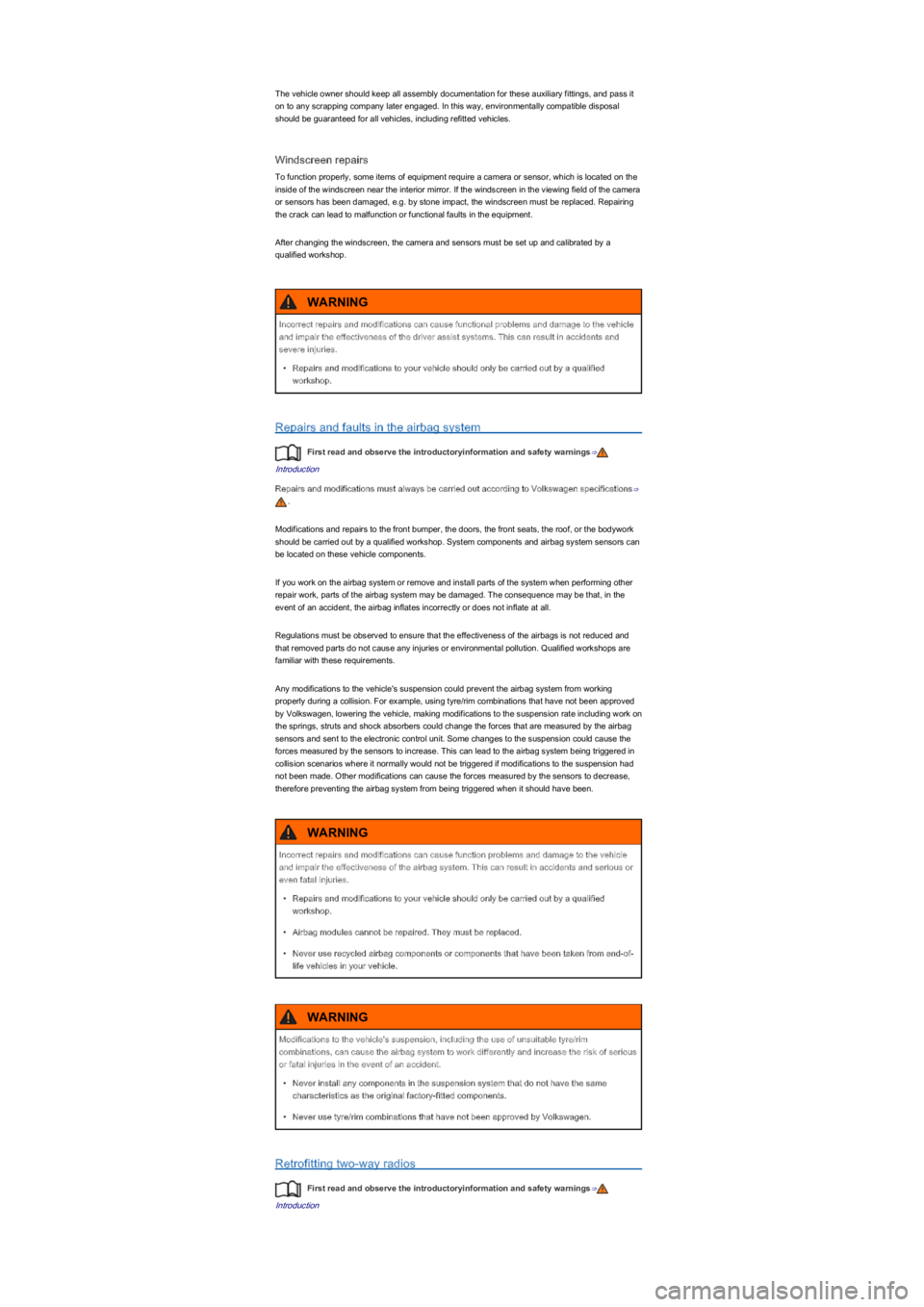
The vehicle owner should keep all assembly documentation for these auxiliary fittings, and pass it
on to any scrapping company later engaged. In this way, environmentally compatible disposal
should be guaranteed for all vehicles, including refitted vehicles.
Windscreen repairs
To function properly, some items of equipment require a camera or sensor, which is located on the
inside of the windscreen near the interior mirror. If the windscreen in the viewing field of the camera
or sensors has been damaged, e.g. by stone impact, the windscreen must be replaced. Repairing
the crack can lead to malfunction or functional faults in the equipment.
After changing the windscreen, the camera and sensors must be set up and calibrated by a
qualified workshop.
Repairs and faults in the airbag system
First read and observe the introductoryinformation and safety warnings⇒
Introduction
Repairs and modifications must always be carried out according to Volkswagen specifications⇒
.
Modifications and repairs to the front bumper, the doors, the front seats, the roof, or the bodywork
should be carried out by a qualified workshop. System components and airbag system sensors can
be located on these vehicle components.
If you work on the airbag system or remove and install parts of the system when performing other
repair work, parts of the airbag system may be damaged. The consequence may be that, in the
event of an accident, the airbag inflates incorrectly or does not inflate at all.
Regulations must be observed to ensure that the effectiveness of the airbags is not reduced and
that removed parts do not cause any injuries or environmental pollution. Qualified workshops are
familiar with these requirements.
Any modifications to the vehicle's suspension could prevent the airbag system from working
properly during a collision. For example, using tyre/rim combinations that have not been approved
by Volkswagen, lowering the vehicle, making modifications to the suspension rate including work on
the springs, struts and shock absorbers could change the forces that are measured by the airbag
sensors and sent to the electronic control unit. Some changes to the suspension could cause the
forces measured by the sensors to increase. This can lead to the airbag system being triggered in
collision scenarios where it normally would not be triggered if modifications to the suspension had
not been made. Other modifications can cause the forces measured by the sensors to decrease,
therefore preventing the airbag system from being triggered when it should have been.
Retrofitting two-way radios
First read and observe the introductoryinformation and safety warnings⇒
Introduction
Incorrect repairs and modifications can cause functional problems and damage to the vehicle
and impair the effectiveness of the driver assist systems. This can result in accidents and
severe injuries.
•Repairs and modifications to your vehicle should only be carried out by a qualified
workshop.
WARNING
Incorrect repairs and modifications can cause function problems and damage to the vehicle
and impair the effectiveness of the airbag system. This can result in accidents and serious or
even fatal injuries.
•Repairs and modifications to your vehicle should only be carried out by a qualified
workshop.
•Airbag modules cannot be repaired. They must be replaced.
•Never use recycled airbag components or components that have been taken from end-of-
life vehicles in your vehicle.
WARNING
Modifications to the vehicle's suspension, including the use of unsuitable tyre/rim
combinations, can cause the airbag system to work differently and increase the risk of serious
or fatal injuries in the event of an accident.
•Never install any components in the suspension system that do not have the same
characteristics as the original factory-fitted components.
•Never use tyre/rim combinations that have not been approved by Volkswagen.
WARNING
Page 172 of 211
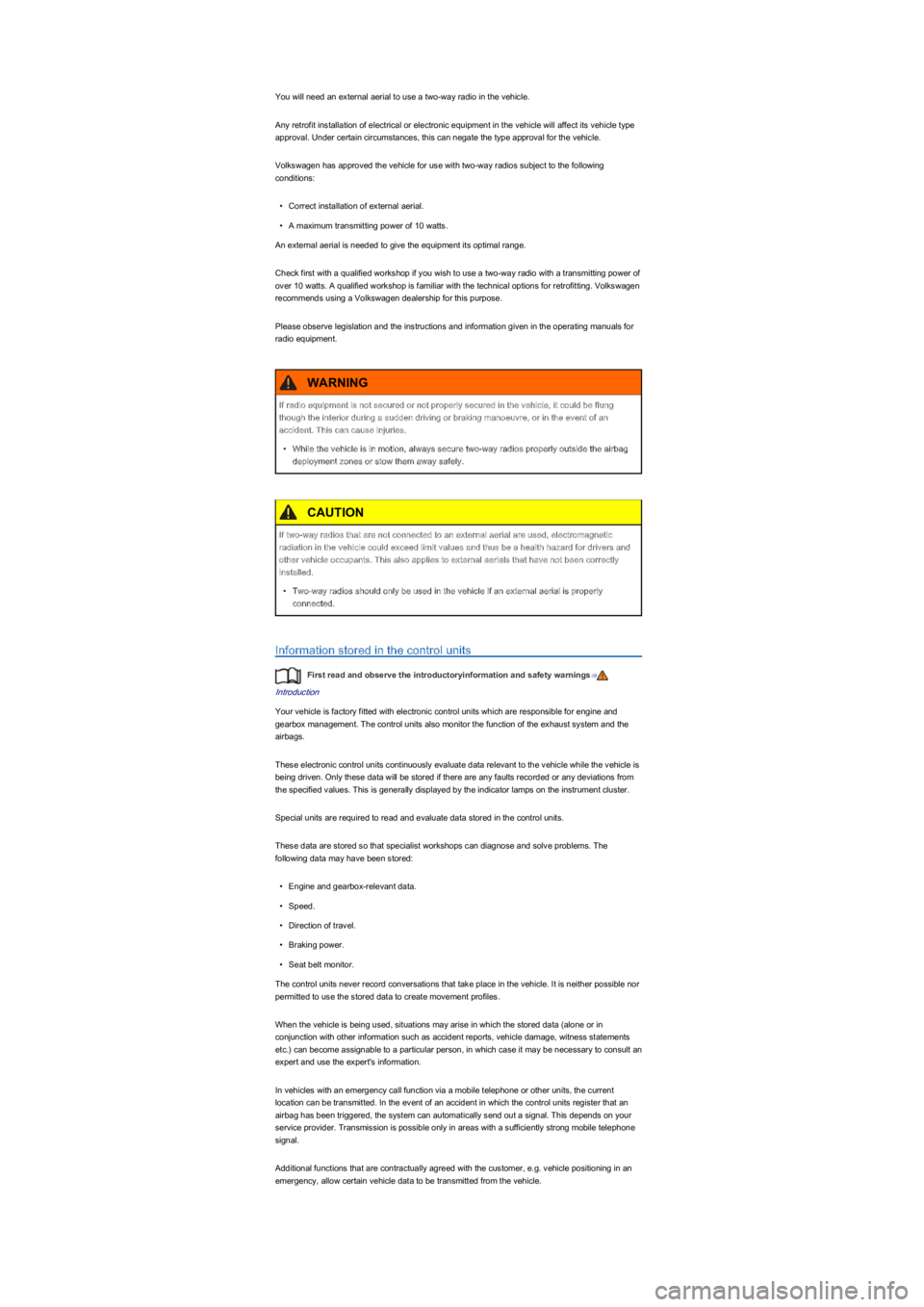
You will need an external aerial to use a two-way radio in the vehicle.
Any retrofit installation of electrical or electronic equipment in the vehicle will affect its vehicle type
approval. Under certain circumstances, this can negate the type approval for the vehicle.
Volkswagen has approved the vehicle for use with two-way radios subject to the following
conditions:
•Correct installation of external aerial.
•A maximum transmitting power of 10 watts.
An external aerial is needed to give the equipment its optimal range.
Check first with a qualified workshop if you wish to use a two-way radio with a transmitting power of
over 10 watts. A qualified workshop is familiar with the technical options for retrofitting. Volkswagen
recommends using a Volkswagen dealership for this purpose.
Please observe legislation and the instructions and information given in the operating manuals for
radio equipment.
Information stored in the control units
First read and observe the introductoryinformation and safety warnings⇒
Introduction
Your vehicle is factory fitted with electronic control units which are responsible for engine and
gearbox management. The control units also monitor the function of the exhaust system and the
airbags.
These electronic control units continuously evaluate data relevant to the vehicle while the vehicle is
being driven. Only these data will be stored if there are any faults recorded or any deviations from
the specified values. This is generally displayed by the indicator lamps on the instrument cluster.
Special units are required to read and evaluate data stored in the control units.
These data are stored so that specialist workshops can diagnose and solve problems. The
following data may have been stored:
•Engine and gearbox-relevant data.
•Speed.
•Direction of travel.
•Braking power.
•Seat belt monitor.
The control units never record conversations that take place in the vehicle. It is neither possible nor
permitted to use the stored data to create movement profiles.
When the vehicle is being used, situations may arise in which the stored data (alone or in
conjunction with other information such as accident reports, vehicle damage, witness statements
etc.) can become assignable to a particular person, in which case it may be necessary to consult an
expert and use the expert's information.
In vehicles with an emergency call function via a mobile telephone or other units, the current
location can be transmitted. In the event of an accident in which the control units register that an
airbag has been triggered, the system can automatically send out a signal. This depends on your
service provider. Transmission is possible only in areas with a sufficiently strong mobile telephone
signal.
Additional functions that are contractually agreed with the customer, e.g. vehicle positioning in an
emergency, allow certain vehicle data to be transmitted from the vehicle.
If radio equipment is not secured or not properly secured in the vehicle, it could be flung
though the interior during a sudden driving or braking manoeuvre, or in the event of an
accident. This can cause injuries.
•While the vehicle is in motion, always secure two-way radios properly outside the airbag
deployment zones or stow them away safely.
WARNING
If two-way radios that are not connected to an external aerial are used, electromagnetic
radiation in the vehicle could exceed limit values and thus be a health hazard for drivers and
other vehicle occupants. This also applies to external aerials that have not been correctly
installed.
•Two-way radios should only be used in the vehicle if an external aerial is properly
connected.
CAUTION
Page 173 of 211

Event data recorder
The vehicle is not fitted with an event data recorder.
Event data recorders temporarily store vehicle information. This provides precise information in the
event of an accident. In vehicles with an airbag system, data that might be relevant in the event of
an accident can be stored, e.g. impact speed, belt buckle status, seat positions and trigger speed.
The scope of the data is manufacturer-specific.
An event data recorder may only be fitted if the owner has approved the procedure. This is covered
by legislation in some countries.
Reprogramming control units
All data for the control of components are stored in the control units. Some convenience functions,
such as lane change flash, single door unlocking and displays, can be reprogrammed using special
workshop equipment. If this is the case, the descriptions in your vehicle wallet will no longer
correspond with the original functions. Volkswagen recommends that you have any reprogramming
confirmed in the service schedule under Workshop comments.
Information about possible reprogramming can be obtained from the Volkswagen dealership.
Reading the vehicle's event memory
A diagnostic interface for reading the event memories is located in the vehicle interior ⇒. Data
relating to the function and status of the electronic control units are stored in the event memory.
Additional information on the stored data is available from qualified workshops.
The diagnosis interface is located behind near the fuse box in the footwell on the driver side.
The event memory should only be read and reset by a qualified workshop.
After a fault has been rectified, the information in the memory pertaining to the fault is deleted.
Other memory content is overwritten on an on-going basis.
Using a mobile telephone in the vehicle without a connection to the
external aerial
First read and observe the introductoryinformation and safety warnings⇒
Introduction
Both during telephone calls and in standby mode, mobile telephones transmit and receive radio
waves, which may also be termed "high-frequency energy". Current scientific literature warns us
that radio waves can be harmful to human beings if they exceed certain limits. Government bodies
and international committees have introduced threshold values and guidelines to ensure that
electromagnetic radiation produced by mobile telephones does not pose a hazard to health.
However, there is no proven scientific evidence that demonstrates that cordless telephones are
absolutely safe.
For this reason, some experts are calling for more precautions to be taken in the use of mobile
telephones, by taking steps to reduce the level of personal exposure to electromagnetic radiation.
If a mobile telephone that is not connected to the vehicle's external aerial is used inside the vehicle,
the level of electromagnetic radiation could be higher than when the mobile telephone is connected
to an integrated aerial or any other external aerial.
If the vehicle is fitted with a suitable hands-free unit which enables the use of innumerable
additional functions of Bluetooth compatible mobile telephones, this will satisfy the legal
requirements in many countries which permit the use of a mobile telephone in a vehicle only if a
hands-free unit is used.
The hands-free system of the portable navigation device (delivered by Volkswagen) in your vehicle
has been developed for mobile telephones that are compatible with Bluetooth⇒ Portable
navigation device. Mobile telephones must be located in a suitable telephone holder or be stored
securely in the vehicle. If a telephone holder is used it must be securely attached to the base plate.
This is the only way to ensure that the mobile telephone is securely attached to the dash panel and
always within reach of the driver. Depending on the hands-free system, the connection between the
mobile telephone and the external aerial is established either via the telephone holder or via an
existing Bluetooth connection between the mobile telephone and the vehicle.
Connecting the mobile telephone is to a telephone aerial integrated in the vehicle or to an external
telephone aerial reduces the electromagnetic radiation generated by the telephone which could
affect the human body. Using an aerial also improves the quality of the signal.
Incorrect use of the diagnostic interface can cause faults, which can result in accidents and
serious injuries.
•Never read the event memory using the diagnostic interface yourself.
•The diagnostic interface should only be read by a qualified workshop.
WARNING
®
®
®
Page 174 of 211
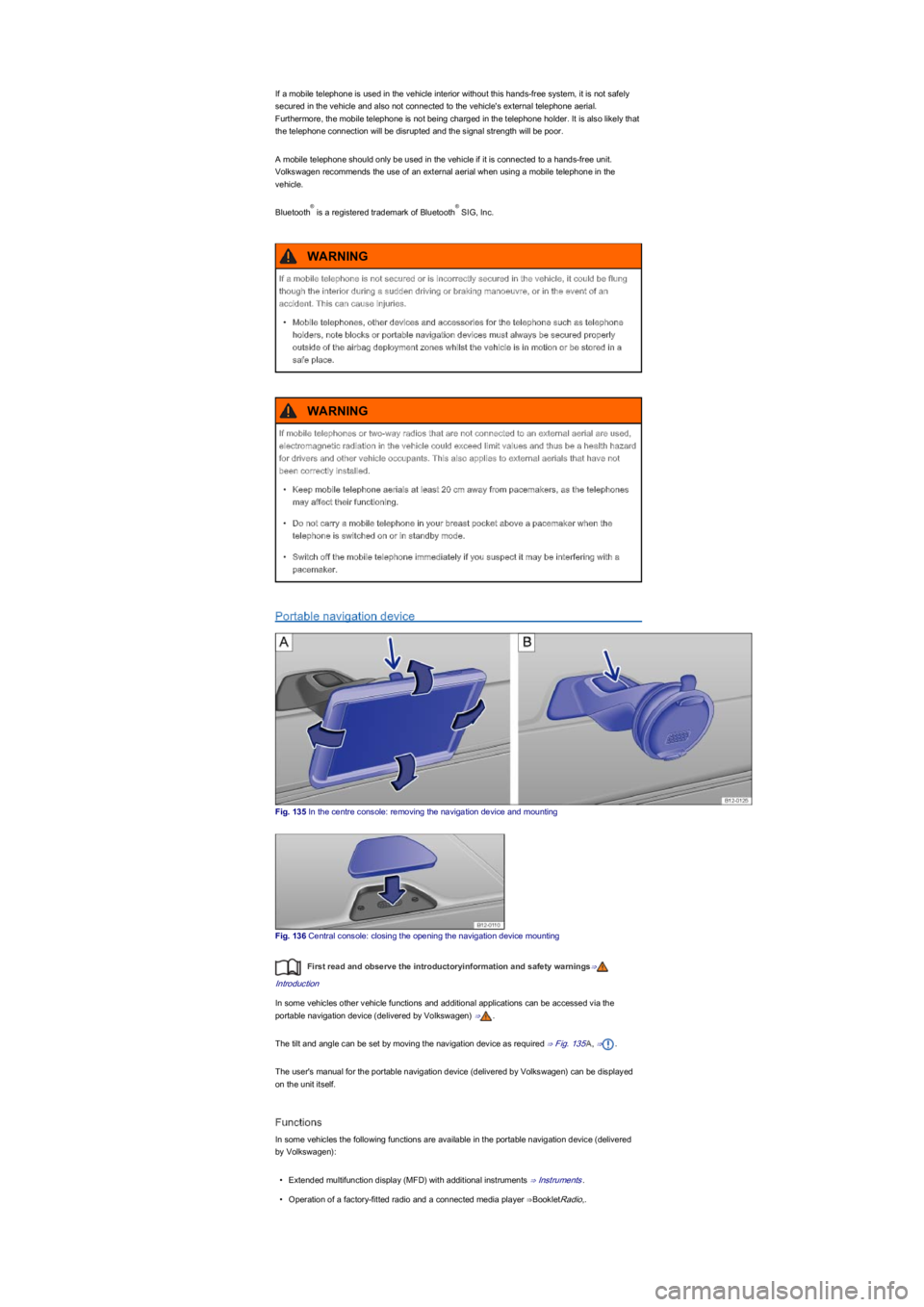
If a mobile telephone is used in the vehicle interior without this hands-free system, it is not safely
secured in the vehicle and also not connected to the vehicle's external telephone aerial.
Furthermore, the mobile telephone is not being charged in the telephone holder. It is also likely that
the telephone connection will be disrupted and the signal strength will be poor.
A mobile telephone should only be used in the vehicle if it is connected to a hands-free unit.
Volkswagen recommends the use of an external aerial when using a mobile telephone in the
vehicle.
Bluetooth is a registered trademark of Bluetooth SIG, Inc.
Portable navigation device
Fig. 135 In the centre console: removing the navigation device and mounting
Fig. 136 Central console: closing the opening the navigation device mounting
First read and observe the introductoryinformation and safety warnings⇒
Introduction
In some vehicles other vehicle functions and additional applications can be accessed via the
portable navigation device (delivered by Volkswagen) ⇒.
The tilt and angle can be set by moving the navigation device as required ⇒ Fig. 135A, ⇒.
The user's manual for the portable navigation device (delivered by Volkswagen) can be displayed
on the unit itself.
Functions
In some vehicles the following functions are available in the portable navigation device (delivered
by Volkswagen):
•Extended multifunction display (MFD) with additional instruments ⇒ Instruments.
•Operation of a factory-fitted radio and a connected media player ⇒BookletRadio,.
®®
If a mobile telephone is not secured or is incorrectly secured in the vehicle, it could be flung
though the interior during a sudden driving or braking manoeuvre, or in the event of an
accident. This can cause injuries.
•Mobile telephones, other devices and accessories for the telephone such as telephone
holders, note blocks or portable navigation devices must always be secured properly
outside of the airbag deployment zones whilst the vehicle is in motion or be stored in a
safe place.
WARNING
If mobile telephones or two-way radios that are not connected to an external aerial are used,
electromagnetic radiation in the vehicle could exceed limit values and thus be a health hazard
for drivers and other vehicle occupants. This also applies to external aerials that have not
been correctly installed.
•Keep mobile telephone aerials at least 20 cm away from pacemakers, as the telephones
may affect their functioning.
•Do not carry a mobile telephone in your breast pocket above a pacemaker when the
telephone is switched on or in standby mode.
•Switch off the mobile telephone immediately if you suspect it may be interfering with a
pacemaker.
WARNING
Page 175 of 211
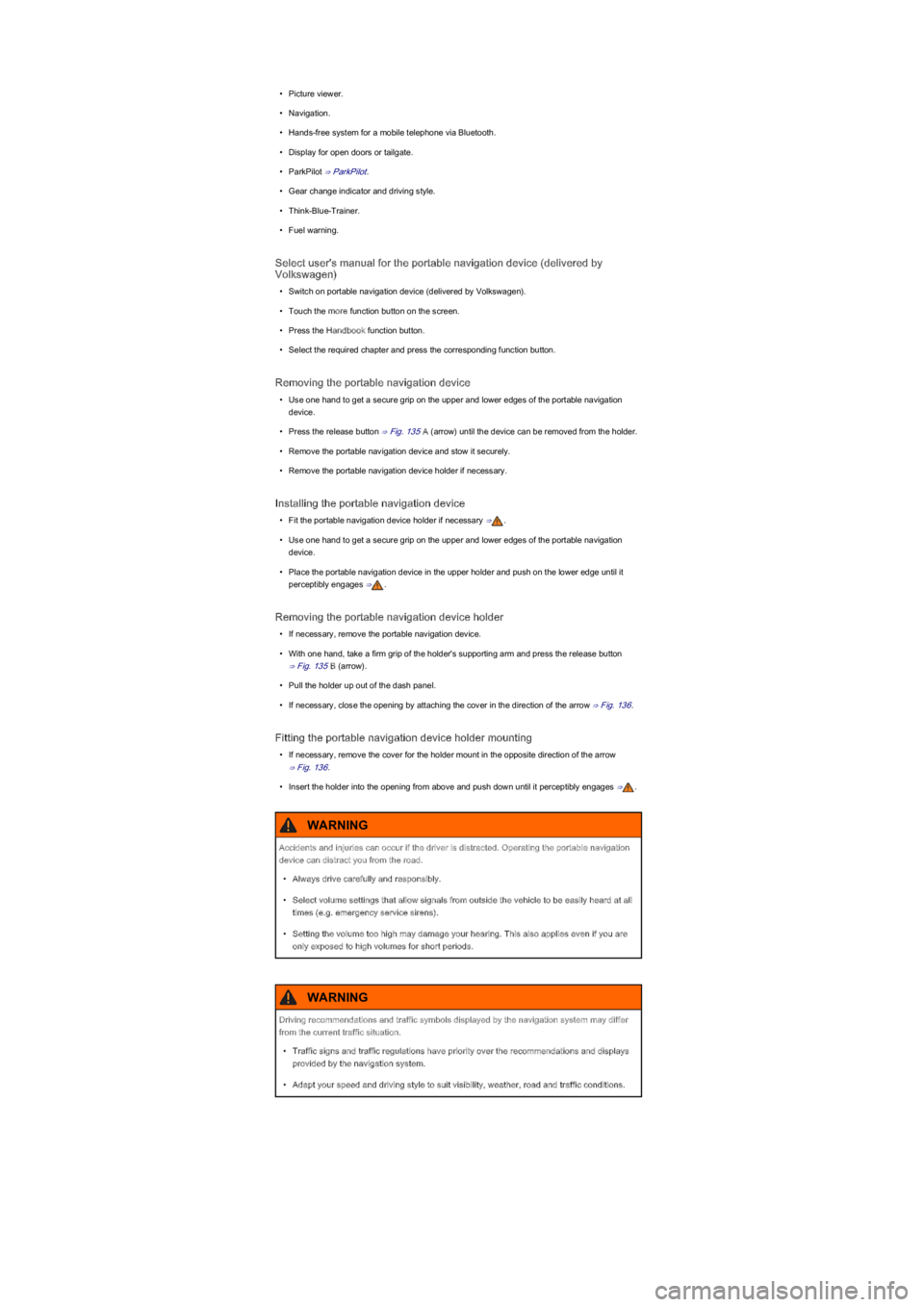
•Picture viewer.
•Navigation.
•Hands-free system for a mobile telephone via Bluetooth.
•Display for open doors or tailgate.
•ParkPilot ⇒ ParkPilot.
•Gear change indicator and driving style.
•Think-Blue-Trainer.
•Fuel warning.
Select user's manual for the portable navigation device (delivered by
Volkswagen)
•Switch on portable navigation device (delivered by Volkswagen).
•Touch the more function button on the screen.
•Press the Handbook function button.
•Select the required chapter and press the corresponding function button.
Removing the portable navigation device
•Use one hand to get a secure grip on the upper and lower edges of the portable navigation
device.
•Press the release button ⇒ Fig. 135A (arrow) until the device can be removed from the holder.
•Remove the portable navigation device and stow it securely.
•Remove the portable navigation device holder if necessary.
Installing the portable navigation device
•Fit the portable navigation device holder if necessary ⇒.
•Use one hand to get a secure grip on the upper and lower edges of the portable navigation
device.
•Place the portable navigation device in the upper holder and push on the lower edge until it
perceptibly engages ⇒.
Removing the portable navigation device holder
•If necessary, remove the portable navigation device.
•With one hand, take a firm grip of the holder's supporting arm and press the release button
⇒ Fig. 135B (arrow).
•Pull the holder up out of the dash panel.
•If necessary, close the opening by attaching the cover in the direction of the arrow ⇒ Fig. 136.
Fitting the portable navigation device holder mounting
•If necessary, remove the cover for the holder mount in the opposite direction of the arrow
⇒ Fig. 136.
•Insert the holder into the opening from above and push down until it perceptibly engages ⇒.
Accidents and injuries can occur if the driver is distracted. Operating the portable navigation
device can distract you from the road.
•Always drive carefully and responsibly.
•Select volume settings that allow signals from outside the vehicle to be easily heard at all
times (e.g. emergency service sirens).
•Setting the volume too high may damage your hearing. This also applies even if you are
only exposed to high volumes for short periods.
WARNING
Driving recommendations and traffic symbols displayed by the navigation system may differ
from the current traffic situation.
•Traffic signs and traffic regulations have priority over the recommendations and displays
provided by the navigation system.
•Adapt your speed and driving style to suit visibility, weather, road and traffic conditions.
WARNING
Page 176 of 211
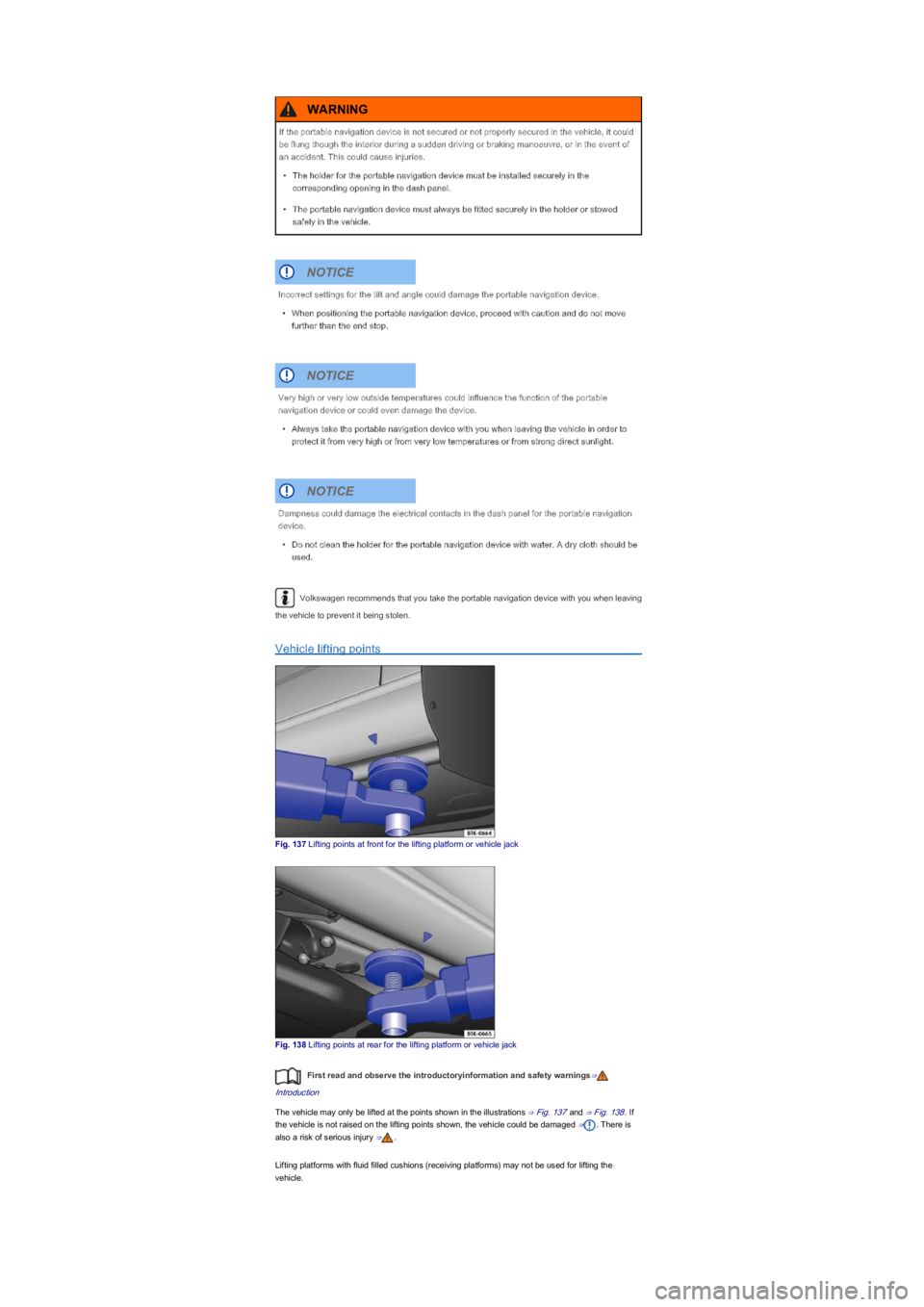
Volkswagen recommends that you take the portable navigation device with you when leaving
the vehicle to prevent it being stolen.
Vehicle lifting points
Fig. 137 Lifting points at front for the lifting platform or vehicle jack
Fig. 138 Lifting points at rear for the lifting platform or vehicle jack
First read and observe the introductoryinformation and safety warnings⇒
Introduction
The vehicle may only be lifted at the points shown in the illustrations ⇒ Fig. 137 and ⇒ Fig. 138. If
the vehicle is not raised on the lifting points shown, the vehicle could be damaged ⇒. There is
also a risk of serious injury ⇒.
Lifting platforms with fluid filled cushions (receiving platforms) may not be used for lifting the
vehicle.
If the portable navigation device is not secured or not properly secured in the vehicle, it could
be flung though the interior during a sudden driving or braking manoeuvre, or in the event of
an accident. This could cause injuries.
•The holder for the portable navigation device must be installed securely in the
corresponding opening in the dash panel.
•The portable navigation device must always be fitted securely in the holder or stowed
safely in the vehicle.
WARNING
Incorrect settings for the tilt and angle could damage the portable navigation device.
•When positioning the portable navigation device, proceed with caution and do not move
further than the end stop.
NOTICE
Very high or very low outside temperatures could influence the function of the portable
navigation device or could even damage the device.
•Always take the portable navigation device with you when leaving the vehicle in order to
protect it from very high or from very low temperatures or from strong direct sunlight.
NOTICE
Dampness could damage the electrical contacts in the dash panel for the portable navigation
device.
•Do not clean the holder for the portable navigation device with water. A dry cloth should be
used.
NOTICE
Page 177 of 211
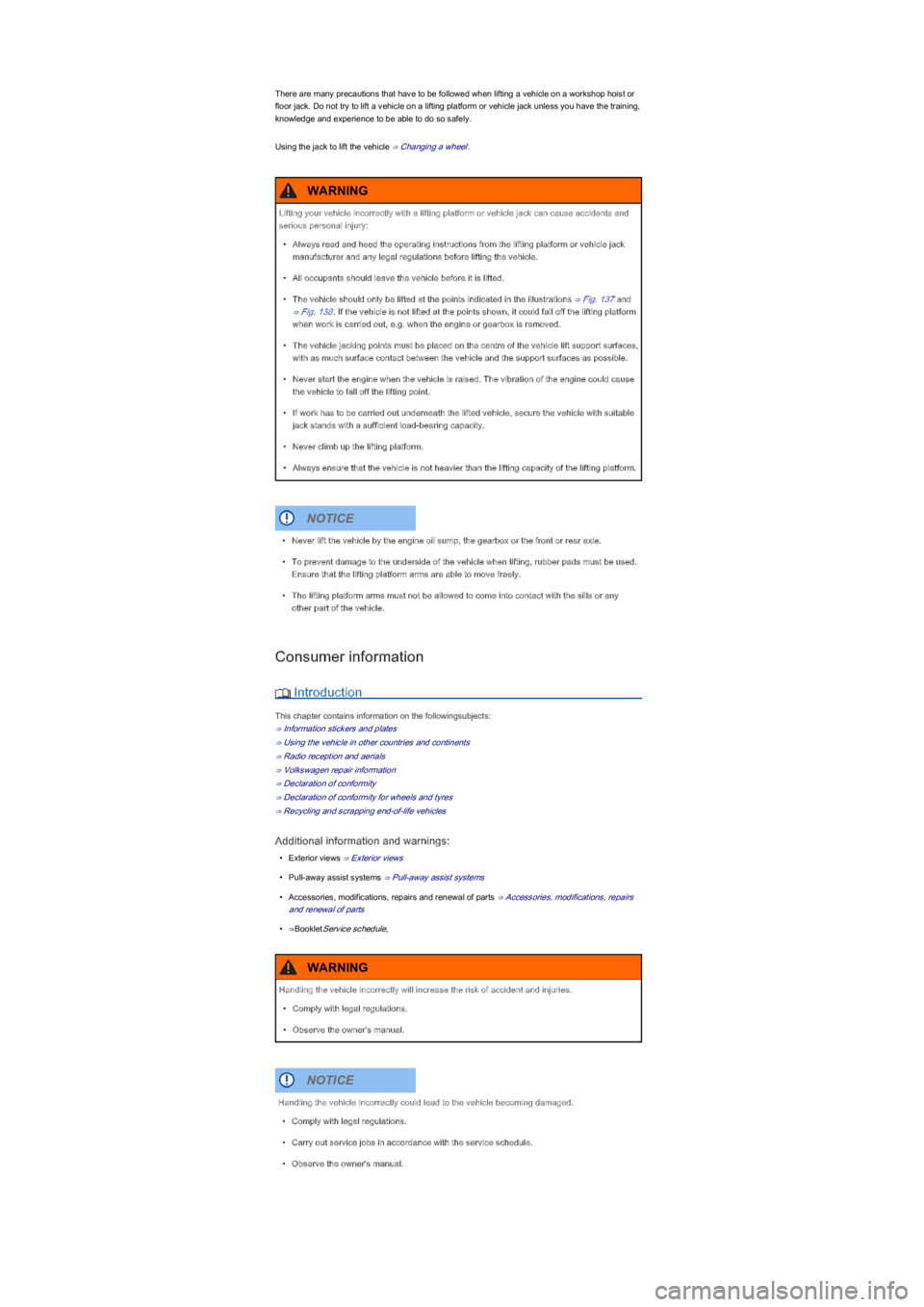
There are many precautions that have to be followed when lifting a vehicle on a workshop hoist or
floor jack. Do not try to lift a vehicle on a lifting platform or vehicle jack unless you have the training,
knowledge and experience to be able to do so safely.
Using the jack to lift the vehicle ⇒ Changing a wheel.
Consumer information
Introduction
This chapter contains information on the followingsubjects:
⇒ Information stickers and plates
⇒ Using the vehicle in other countries and continents
⇒ Radio reception and aerials
⇒ Volkswagen repair information
⇒ Declaration of conformity
⇒ Declaration of conformity for wheels and tyres
⇒ Recycling and scrapping end-of-life vehicles
Additional information and warnings:
•Exterior views ⇒ Exterior views
•Pull-away assist systems ⇒ Pull-away assist systems
•Accessories, modifications, repairs and renewal of parts ⇒ Accessories, modifications, repairs
and renewal of parts
•⇒BookletService schedule,
Lifting your vehicle incorrectly with a lifting platform or vehicle jack can cause accidents and
serious personal injury:
•Always read and heed the operating instructions from the lifting platform or vehicle jack
manufacturer and any legal regulations before lifting the vehicle.
•All occupants should leave the vehicle before it is lifted.
•The vehicle should only be lifted at the points indicated in the illustrations ⇒ Fig. 137 and
⇒ Fig. 138. If the vehicle is not lifted at the points shown, it could fall off the lifting platform
when work is carried out, e.g. when the engine or gearbox is removed.
•The vehicle jacking points must be placed on the centre of the vehicle lift support surfaces,
with as much surface contact between the vehicle and the support surfaces as possible.
•Never start the engine when the vehicle is raised. The vibration of the engine could cause
the vehicle to fall off the lifting point.
•If work has to be carried out underneath the lifted vehicle, secure the vehicle with suitable
jack stands with a sufficient load-bearing capacity.
•Never climb up the lifting platform.
•Always ensure that the vehicle is not heavier than the lifting capacity of the lifting platform.
WARNING
•Never lift the vehicle by the engine oil sump, the gearbox or the front or rear axle.
•To prevent damage to the underside of the vehicle when lifting, rubber pads must be used.
Ensure that the lifting platform arms are able to move freely.
•The lifting platform arms must not be allowed to come into contact with the sills or any
other part of the vehicle.
NOTICE
Handling the vehicle incorrectly will increase the risk of accident and injuries.
•Comply with legal regulations.
•Observe the owner's manual.
WARNING
Handling the vehicle incorrectly could lead to the vehicle becoming damaged.
•Comply with legal regulations.
•Carry out service jobs in accordance with the service schedule.
•Observe the owner's manual.
NOTICE
Page 178 of 211
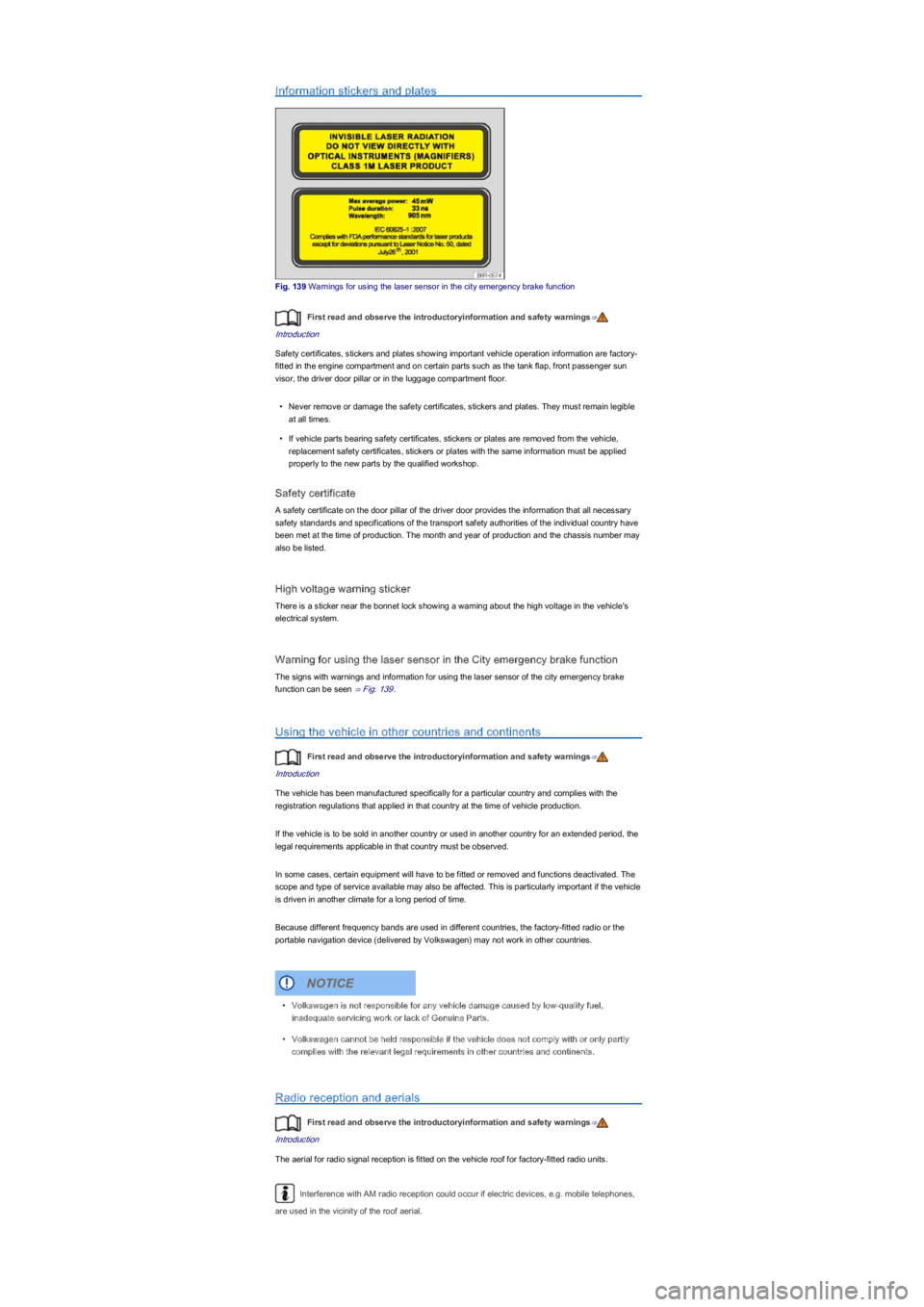
Information stickers and plates
Fig. 139 Warnings for using the laser sensor in the city emergency brake function
First read and observe the introductoryinformation and safety warnings⇒
Introduction
Safety certificates, stickers and plates showing important vehicle operation information are factory-
fitted in the engine compartment and on certain parts such as the tank flap, front passenger sun
visor, the driver door pillar or in the luggage compartment floor.
•Never remove or damage the safety certificates, stickers and plates. They must remain legible
at all times.
•If vehicle parts bearing safety certificates, stickers or plates are removed from the vehicle,
replacement safety certificates, stickers or plates with the same information must be applied
properly to the new parts by the qualified workshop.
Safety certificate
A safety certificate on the door pillar of the driver door provides the information that all necessary
safety standards and specifications of the transport safety authorities of the individual country have
been met at the time of production. The month and year of production and the chassis number may
also be listed.
High voltage warning sticker
There is a sticker near the bonnet lock showing a warning about the high voltage in the vehicle's
electrical system.
Warning for using the laser sensor in the City emergency brake function
The signs with warnings and information for using the laser sensor of the city emergency brake
function can be seen ⇒ Fig. 139.
Using the vehicle in other countries and continents
First read and observe the introductoryinformation and safety warnings⇒
Introduction
The vehicle has been manufactured specifically for a particular country and complies with the
registration regulations that applied in that country at the time of vehicle production.
If the vehicle is to be sold in another country or used in another country for an extended period, the
legal requirements applicable in that country must be observed.
In some cases, certain equipment will have to be fitted or removed and functions deactivated. The
scope and type of service available may also be affected. This is particularly important if the vehicle
is driven in another climate for a long period of time.
Because different frequency bands are used in different countries, the factory-fitted radio or the
portable navigation device (delivered by Volkswagen) may not work in other countries.
Radio reception and aerials
First read and observe the introductoryinformation and safety warnings⇒
Introduction
The aerial for radio signal reception is fitted on the vehicle roof for factory-fitted radio units.
Interference with AM radio reception could occur if electric devices, e.g. mobile telephones,
are used in the vicinity of the roof aerial.
•Volkswagen is not responsible for any vehicle damage caused by low-quality fuel,
inadequate servicing work or lack of Genuine Parts.
•Volkswagen cannot be held responsible if the vehicle does not comply with or only partly
complies with the relevant legal requirements in other countries and continents.
NOTICE
Page 179 of 211
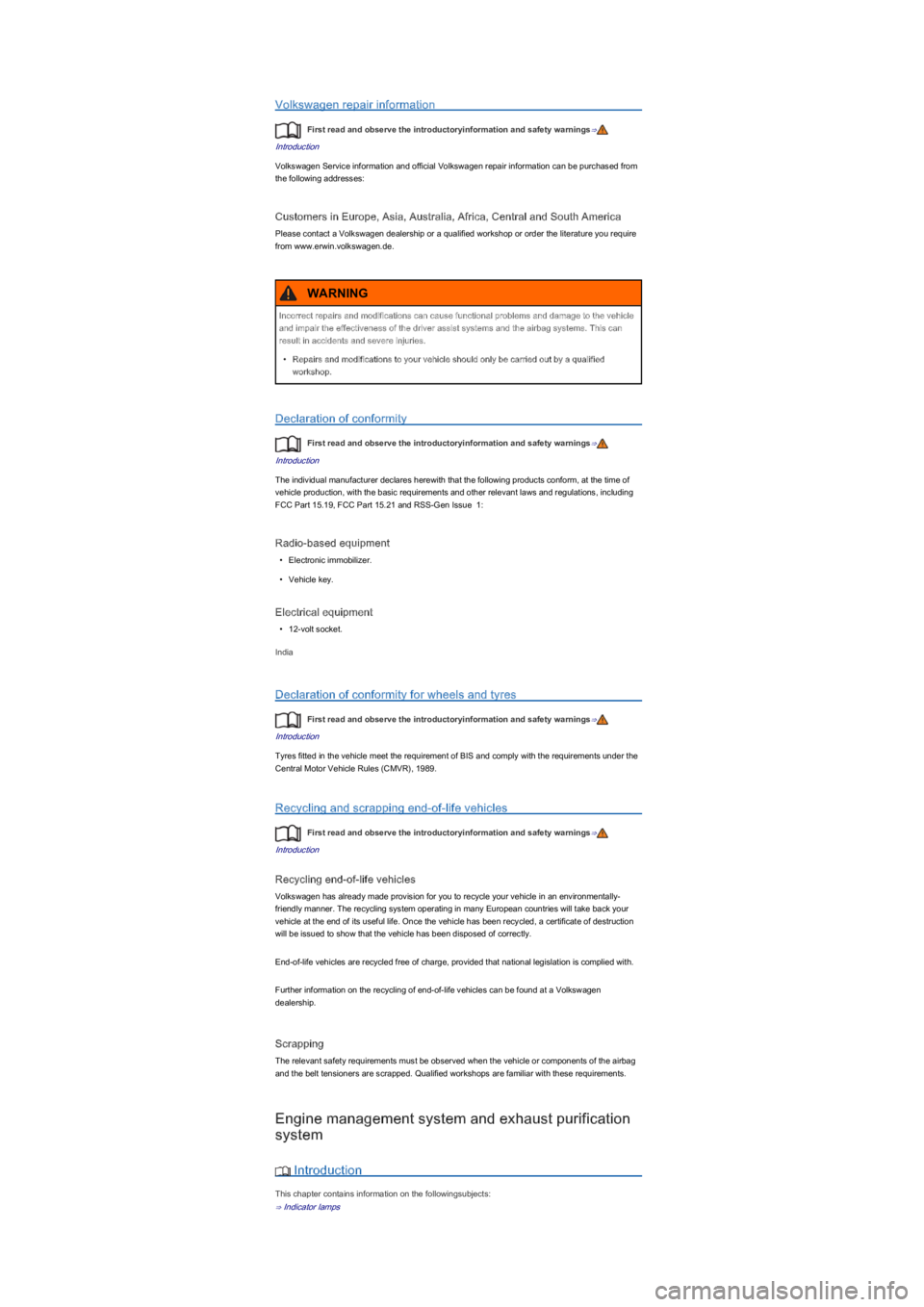
Volkswagen repair information
First read and observe the introductoryinformation and safety warnings⇒
Introduction
Volkswagen Service information and official Volkswagen repair information can be purchased from
the following addresses:
Customers in Europe, Asia, Australia, Africa, Central and South America
Please contact a Volkswagen dealership or a qualified workshop or order the literature you require
from www.erwin.volkswagen.de.
Declaration of conformity
First read and observe the introductoryinformation and safety warnings⇒
Introduction
The individual manufacturer declares herewith that the following products conform, at the time of
vehicle production, with the basic requirements and other relevant laws and regulations, including
FCC Part 15.19, FCC Part 15.21 and RSS-Gen Issue 1:
Radio-based equipment
•Electronic immobilizer.
•Vehicle key.
Electrical equipment
•12-volt socket.
India
Declaration of conformity for wheels and tyres
First read and observe the introductoryinformation and safety warnings⇒
Introduction
Tyres fitted in the vehicle meet the requirement of BIS and comply with the requirements under the
Central Motor Vehicle Rules (CMVR), 1989.
Recycling and scrapping end-of-life vehicles
First read and observe the introductoryinformation and safety warnings⇒
Introduction
Recycling end-of-life vehicles
Volkswagen has already made provision for you to recycle your vehicle in an environmentally-
friendly manner. The recycling system operating in many European countries will take back your
vehicle at the end of its useful life. Once the vehicle has been recycled, a certificate of destruction
will be issued to show that the vehicle has been disposed of correctly.
End-of-life vehicles are recycled free of charge, provided that national legislation is complied with.
Further information on the recycling of end-of-life vehicles can be found at a Volkswagen
dealership.
Scrapping
The relevant safety requirements must be observed when the vehicle or components of the airbag
and the belt tensioners are scrapped. Qualified workshops are familiar with these requirements.
Engine management system and exhaust purification
system
Introduction
This chapter contains information on the followingsubjects:
⇒ Indicator lamps
Incorrect repairs and modifications can cause functional problems and damage to the vehicle
and impair the effectiveness of the driver assist systems and the airbag systems. This can
result in accidents and severe injuries.
•Repairs and modifications to your vehicle should only be carried out by a qualified
workshop.
WARNING
Page 180 of 211
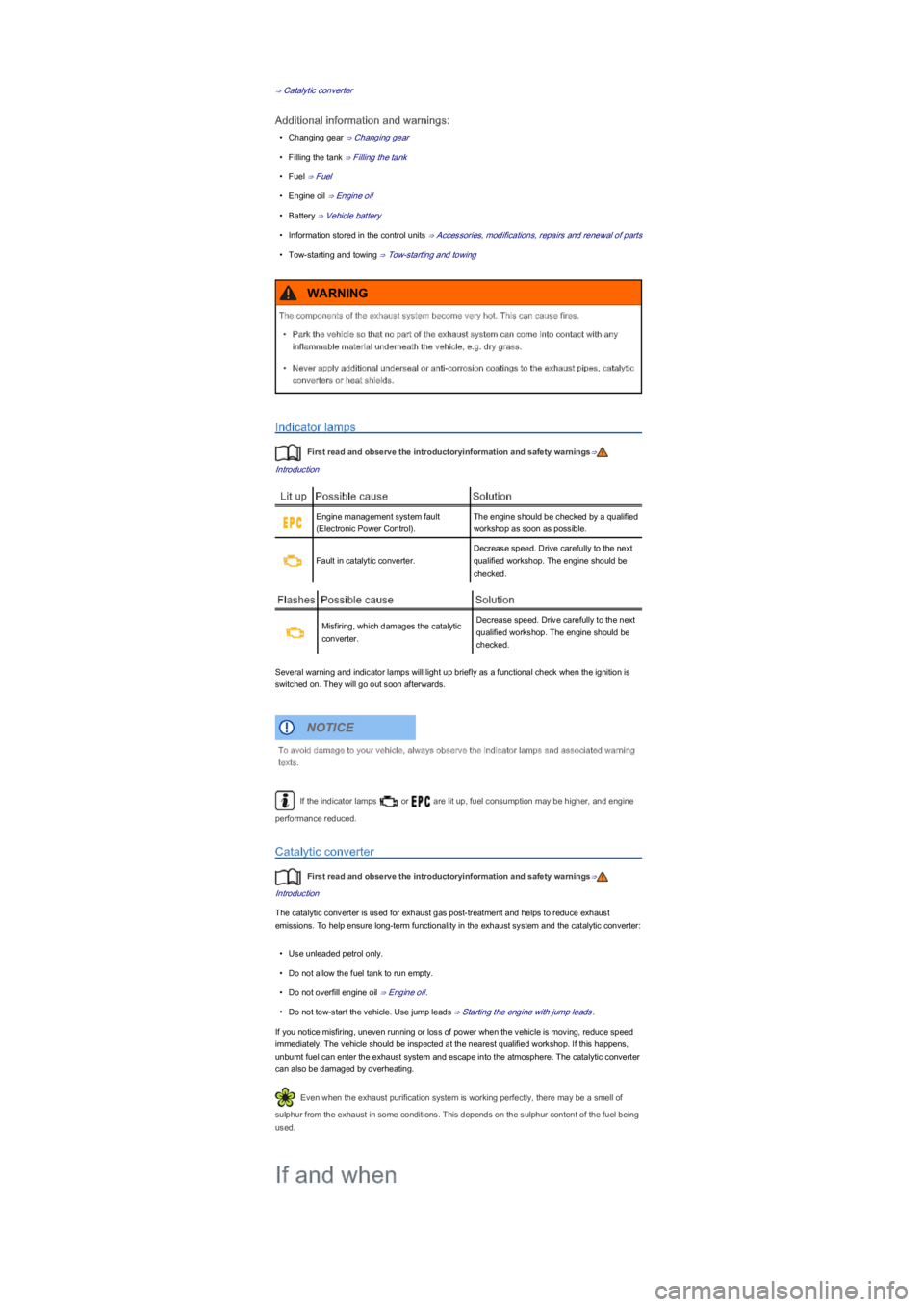
⇒ Catalytic converter
Additional information and warnings:
•Changing gear ⇒ Changing gear
•Filling the tank ⇒ Filling the tank
•Fuel ⇒ Fuel
•Engine oil ⇒ Engine oil
•Battery ⇒ Vehicle battery
•Information stored in the control units ⇒ Accessories, modifications, repairs and renewal of parts
•Tow-starting and towing ⇒ Tow-starting and towing
Indicator lamps
First read and observe the introductoryinformation and safety warnings⇒
Introduction
Lit upPossible causeSolution
Engine management system fault
(Electronic Power Control).
The engine should be checked by a qualified
workshop as soon as possible.
Fault in catalytic converter.
Decrease speed. Drive carefully to the next
qualified workshop. The engine should be
checked.
FlashesPossible causeSolution
Misfiring, which damages the catalytic
converter.
Decrease speed. Drive carefully to the next
qualified workshop. The engine should be
checked.
Several warning and indicator lamps will light up briefly as a functional check when the ignition is
switched on. They will go out soon afterwards.
If the indicator lamps or are lit up, fuel consumption may be higher, and engine
performance reduced.
Catalytic converter
First read and observe the introductoryinformation and safety warnings⇒
Introduction
The catalytic converter is used for exhaust gas post-treatment and helps to reduce exhaust
emissions. To help ensure long-term functionality in the exhaust system and the catalytic converter:
•Use unleaded petrol only.
•Do not allow the fuel tank to run empty.
•Do not overfill engine oil ⇒ Engine oil.
•Do not tow-start the vehicle. Use jump leads ⇒ Starting the engine with jump leads.
If you notice misfiring, uneven running or loss of power when the vehicle is moving, reduce speed
immediately. The vehicle should be inspected at the nearest qualified workshop. If this happens,
unburnt fuel can enter the exhaust system and escape into the atmosphere. The catalytic converter
can also be damaged by overheating.
Even when the exhaust purification system is working perfectly, there may be a smell of
sulphur from the exhaust in some conditions. This depends on the sulphur content of the fuel being
used.
The components of the exhaust system become very hot. This can cause fires.
•Park the vehicle so that no part of the exhaust system can come into contact with any
inflammable material underneath the vehicle, e.g. dry grass.
•Never apply additional underseal or anti-corrosion coatings to the exhaust pipes, catalytic
converters or heat shields.
WARNING
To avoid damage to your vehicle, always observe the indicator lamps and associated warning
texts.
NOTICE
If and when